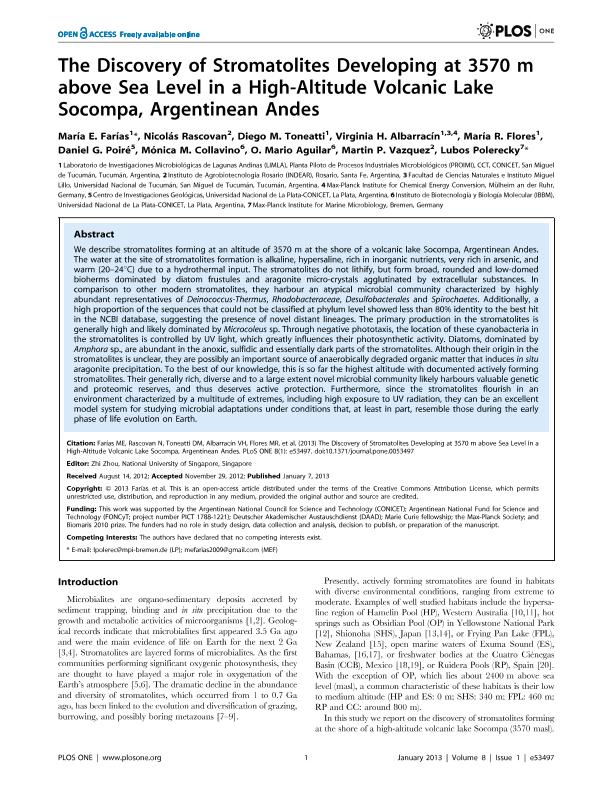Mostrar el registro sencillo del ítem
dc.contributor.author
Farías, María Eugenia
dc.contributor.author
Rascovan, Nicolas

dc.contributor.author
Toneatti, Diego

dc.contributor.author
Albarracín, Virginia Helena

dc.contributor.author
Flores, María Regina

dc.contributor.author
Poire, Daniel Gustavo

dc.contributor.author
Collavino, Mónica Mariana

dc.contributor.author
Aguilar, Orlando Mario

dc.contributor.author
Vazquez, Martin Pablo

dc.contributor.author
Polerecky, Lubos
dc.date.available
2019-12-12T20:14:21Z
dc.date.issued
2013-01
dc.identifier.citation
Farías, María Eugenia; Rascovan, Nicolas; Toneatti, Diego; Albarracín, Virginia Helena; Flores, María Regina; et al.; Discovery of Stromatolites Developing under Extreme Conditions in the Andeans Lakes.; Public Library of Science; Plos One; 8; 1; 1-2013
dc.identifier.issn
1932-6203
dc.identifier.uri
http://hdl.handle.net/11336/92133
dc.description.abstract
We describe stromatolites forming at an altitude of 3570 m at the shore of a volcanic lake Socompa, Argentinean Andes. The water at the site of stromatolites formation is alkaline, hypersaline, rich in inorganic nutrients, very rich in arsenic, and warm (20-24°C) due to a hydrothermal input. The stromatolites do not lithify, but form broad, rounded and low-domed bioherms dominated by diatom frustules and aragonite micro-crystals agglutinated by extracellular substances. In comparison to other modern stromatolites, they harbour an atypical microbial community characterized by highly abundant representatives of Deinococcus-Thermus, Rhodobacteraceae, Desulfobacterales and Spirochaetes. Additionally, a high proportion of the sequences that could not be classified at phylum level showed less than 80% identity to the best hit in the NCBI database, suggesting the presence of novel distant lineages. The primary production in the stromatolites is generally high and likely dominated by Microcoleus sp. Through negative phototaxis, the location of these cyanobacteria in the stromatolites is controlled by UV light, which greatly influences their photosynthetic activity. Diatoms, dominated by Amphora sp., are abundant in the anoxic, sulfidic and essentially dark parts of the stromatolites. Although their origin in the stromatolites is unclear, they are possibly an important source of anaerobically degraded organic matter that induces in situ aragonite precipitation. To the best of our knowledge, this is so far the highest altitude with documented actively forming stromatolites. Their generally rich, diverse and to a large extent novel microbial community likely harbours valuable genetic and proteomic reserves, and thus deserves active protection. Furthermore, since the stromatolites flourish in an environment characterized by a multitude of extremes, including high exposure to UV radiation, they can be an excellent model system for studying microbial adaptations under conditions that, at least in part, resemble those during the early phase of life evolution on Earth.
dc.format
application/pdf
dc.language.iso
eng
dc.publisher
Public Library of Science

dc.rights
info:eu-repo/semantics/openAccess
dc.rights.uri
https://creativecommons.org/licenses/by-nc-sa/2.5/ar/
dc.subject
extreme environmets
dc.subject
high-altitud lakes
dc.subject
stromatolites
dc.subject
diversity
dc.subject.classification
Ciencias Medioambientales

dc.subject.classification
Ciencias de la Tierra y relacionadas con el Medio Ambiente

dc.subject.classification
CIENCIAS NATURALES Y EXACTAS

dc.title
Discovery of Stromatolites Developing under Extreme Conditions in the Andeans Lakes.
dc.type
info:eu-repo/semantics/article
dc.type
info:ar-repo/semantics/artículo
dc.type
info:eu-repo/semantics/publishedVersion
dc.date.updated
2019-12-11T18:47:40Z
dc.journal.volume
8
dc.journal.number
1
dc.journal.pais
Estados Unidos

dc.journal.ciudad
San Francisco
dc.description.fil
Fil: Farías, María Eugenia. Consejo Nacional de Investigaciones Científicas y Técnicas. Centro Científico Tecnológico Conicet - Tucumán. Planta Piloto de Procesos Industriales Microbiológicos; Argentina
dc.description.fil
Fil: Rascovan, Nicolas. Consejo Nacional de Investigaciones Científicas y Técnicas. Instituto de Investigaciones en Ingeniería Genética y Biología Molecular "Dr. Héctor N. Torres"; Argentina
dc.description.fil
Fil: Toneatti, Diego. Consejo Nacional de Investigaciones Científicas y Técnicas. Centro Científico Tecnológico Conicet - Tucumán. Planta Piloto de Procesos Industriales Microbiológicos; Argentina
dc.description.fil
Fil: Albarracín, Virginia Helena. Consejo Nacional de Investigaciones Científicas y Técnicas. Centro Científico Tecnológico Conicet - Tucumán. Planta Piloto de Procesos Industriales Microbiológicos; Argentina
dc.description.fil
Fil: Flores, María Regina. Consejo Nacional de Investigaciones Científicas y Técnicas. Centro Científico Tecnológico Conicet - Tucumán. Planta Piloto de Procesos Industriales Microbiológicos; Argentina
dc.description.fil
Fil: Poire, Daniel Gustavo. Consejo Nacional de Investigaciones Científicas y Técnicas. Centro Científico Tecnológico Conicet - La Plata. Centro de Investigaciones Geológicas. Universidad Nacional de La Plata. Facultad de Ciencias Naturales y Museo. Centro de Investigaciones Geológicas; Argentina
dc.description.fil
Fil: Collavino, Mónica Mariana. Consejo Nacional de Investigaciones Científicas y Técnicas. Centro Científico Tecnológico Conicet - Nordeste. Instituto de Botánica del Nordeste. Universidad Nacional del Nordeste. Facultad de Ciencias Agrarias. Instituto de Botánica del Nordeste; Argentina
dc.description.fil
Fil: Aguilar, Orlando Mario. Consejo Nacional de Investigaciones Científicas y Técnicas. Centro Científico Tecnológico Conicet - La Plata. Instituto de Biotecnología y Biología Molecular. Universidad Nacional de La Plata. Facultad de Ciencias Exactas. Instituto de Biotecnología y Biología Molecular; Argentina
dc.description.fil
Fil: Vazquez, Martin Pablo. Consejo Nacional de Investigaciones Científicas y Técnicas. Instituto de Investigación en Ingeniería Genética y Biología Molecular "Dr. Héctor N. Torres". Grupo Vinculado al INGEBI- Laboratorio de Biocatálisis y Biotransformaciones - LBB - UNQUI; Argentina
dc.description.fil
Fil: Polerecky, Lubos. Instituto Max Planck Institut für Chemische Okologie; Alemania
dc.journal.title
Plos One

dc.relation.alternativeid
info:eu-repo/semantics/altIdentifier/url/http://www.ncbi.nlm.nih.gov/pmc/articles/PMC3538587/
dc.relation.alternativeid
info:eu-repo/semantics/altIdentifier/doi/https://dx.doi.org/10.1371%2Fjournal.pone.0053497
Archivos asociados
